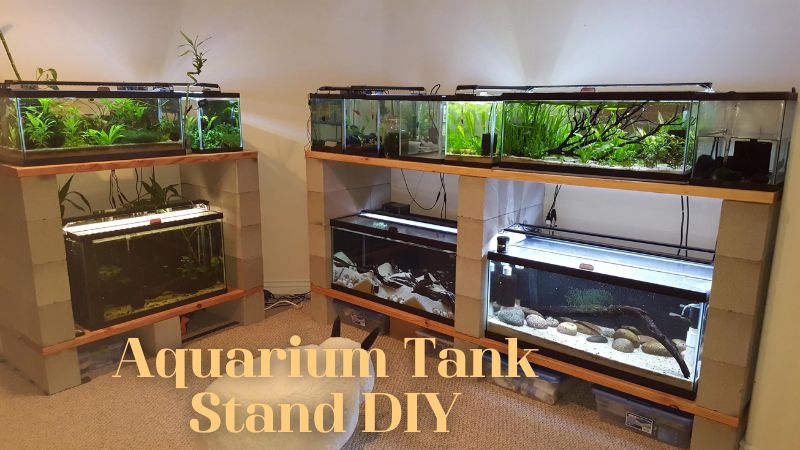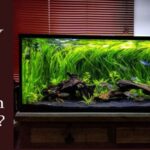An aquarium tank stand is not just a functional piece of furniture, it’s also a crucial component that ensures the safety and stability of your aquarium setup. While pre-made stands are available, building your own DIY aquarium stand can be a rewarding project that allows you to customize the dimensions, style, and materials to perfectly suit your space and aquarium needs. Below Tropical Fish Haven will provide comprehensive instructions on how to build your own Aquarium Tank Stand DIY
Aquarium tank stand DIY
Planning Your DIY Aquarium Tank Stand
Before diving into construction, careful planning is essential to ensure your DIY aquarium stand is sturdy enough to support the weight of your aquarium and withstand potential water damage. Consider the following steps:
- Measurements and Dimensions: Measure the footprint of your aquarium, including its length, width, and height. The stand should be slightly larger than the base of the aquarium to provide ample support.
- Weight Capacity: Calculate the total weight of your aquarium when filled with water, substrate, and decorations. Ensure the stand you build can comfortably support this weight without sagging or compromising stability.
- Materials: Choose high-quality, water-resistant materials such as plywood, solid wood, or medium-density fiberboard (MDF). Avoid using materials that can warp or deteriorate when exposed to moisture.
- Design and Style: Decide on the design aesthetic that matches your home décor and personal preferences. You can opt for a sleek, minimalist design or add decorative elements to complement your aquarium.
Building Your DIY Aquarium Tank Stand
Once you have a clear plan and the necessary materials, follow these steps to build your DIY aquarium tank stand:
Materials Needed:
Lumber: Depending on your design, choose lumber that is sturdy and can support heavy loads. 2x4s or 4x4s are commonly used for the frame, while plywood is ideal for the panels.
- Screws and Nails: Use appropriate screws or nails for woodworking, ensuring they are corrosion-resistant if they might come into contact with water.
- Wood Glue: Provides additional strength and stability when assembling parts.
- Paint or Stain: Optionally, finish the stand with paint or stain to protect it from moisture and enhance its appearance.
- Tools: Essential tools include a circular saw or table saw, drill/driver, measuring tape, level, and clamps for assembly.
Step-by-Step Construction:
Cutting the Lumber: Begin by cutting the lumber to the required dimensions based on your design plan. Measure and mark carefully to ensure precise cuts.
Assembling the Frame: Construct the frame using the cut lumber pieces, ensuring it is square and level. Reinforce corners with corner brackets if necessary for added stability.
Adding Panels: Attach plywood or other chosen materials to the sides and top of the frame to create a solid surface for the aquarium. Ensure all edges are flush and use wood glue along with screws or nails to secure the panels.
Finishing Touches: Sand any rough edges and apply paint or stain as desired. Allow adequate drying time before placing the aquarium on the stand.
Choose the aquarium size and style
Choosing the size and style of the aquarium is the first and extremely important step. The tank is not simply a water storage block, but also a living room for aquatic plants and ornamental fish, creating a beautiful and balanced ecosystem. In the process of choosing a tank, considering the size ensures that it fits the indoor space as well as the fish and plant habitat. The appropriate depth of the tank usually ranges from 30cm to 60cm to create ideal conditions for the growth of plants and fish.
You can choose to buy an empty tank to design it according to your personal preferences or buy a pre-decorated tank to save time. Learn about aquarium playing styles to get inspiration for easy tank design and guidance in future tank care.
Select aquatic plants and fish
When entering the world of fish and aquatic life, adding aquatic plants is not just a decorative decision but also the building of a vibrant environment that reflects the harmony of nature in your aquarium space. Friend. First of all, learn about aquatic plants and choose those that are suitable for the lighting and water conditions in the tank. Anubias, Java Moss, or Vallisneria can be great choices for beginners.
The process of placing plants in a pond is somewhat artistic, where height, size, and placement all play important roles. You can arrange aquatic plants from high to low, creating a beautiful dynamic scene and interacting with the space in a harmonious way. The space between the trees not only allows fish to move freely, but also increases the openness and naturalness of the lake.
In addition, choosing fish species that can live with aquatic plants is equally important. Fish species that can live with aquatic plants must be suitable for the growth environment of that plant. You can learn about small fish species that are easy to care for.
Tips for Success
- Leveling: Use a level during construction to ensure the stand remains even and stable. Uneven surfaces can stress the aquarium glass and lead to leaks.
- Waterproofing: Apply a waterproof sealant or marine-grade varnish to protect the stand from water damage, especially around joints and edges.
- Weight Distribution: Distribute the weight evenly across the stand, especially for larger aquariums. Consider adding additional support beams or braces if needed.
How to Make a Simple Aquarium
Choosing a substrate for aquariums
In the process of building an aquarium, choosing the substrate is a basic but decisive step to ensure the development and prosperity of the entire aquatic plant system. Substrate, that is, the layer of soil or material placed under the layer of sand or gravel, is not only the foundation but also a source of nutrients and address for aquatic plants.
Choosing a quality fertilizer is important to ensure that aquatic plants are provided with the necessary nutrients. Specialized aquatic soil or a mixture of aquatic soil and fertilizer is a popular choice, ensuring the supply of necessary minerals and uniform water retention, creating favorable conditions for plant growth.
Not only do you have to choose the right type of soil for aquatic plants, but you also have to learn about the specific characteristics of each type of plant. Flexible combinations of aquatic soil types can create a diverse, optimal mixture for uniform plant growth.
Choose the bottom and decorations for the aquarium
After choosing the appropriate substrate, you can spread an additional layer of substrate on top to cover the substrate to match the design and aesthetics of the tank and choose decorative items to make the tank more unique and outstanding.
For example, sand bottoms are a popular choice for aquariums. Sand has the ability to provide a relatively good environment for aquatic plants to take root and provide a place for fish to hunt, as well as creating a natural look for the aquarium. In addition to sand bottom, there are many other types of bottom such as cement, gravel,… or a combination of them.
You will be surprised to know the benefits that fish tank decorations bring!
Decorations not only create an interesting space, they also create a natural habitat for fish, shrimp, and aquatic plants to grow like in nature. Ornaments provide an environment for microorganisms and create a natural food source.
Decorative objects such as rocks, trees, driftwood, and caves provide hiding areas for fish. This helps reduce stress on the fish, making them feel safer.
Building a Filtration System
The filtration system is an indispensable part when building an aquarium, especially to maintain a healthy water environment for fish and other organisms. There are three main types of filtration systems that you can consider when building your aquarium: compartmental filtration, hanging filtration, and convenient barrel filtration.
Hanging filtration uses a continuous stream of water to remove sediment and oxygenate the water. Hanging filter is a product made from filter materials such as small ceramic filters (gold ring ceramic, sesame ball ceramic, mixed ball, square ceramic,…) combined with filter cotton, or filter pads, black filter foam, 8D filter. The line-hanging filter is combined with water discharge devices such as a rain system, speculum, and redirects the water back to the tank, making it interesting and beautiful for the tank.
The disadvantage of hanging filters is that they are only for tanks and aquariums under 90cm, aquariums with few organisms, or filter support when the tank already has a main filter.
Filter system divided into compartments: includes pump compartment, ceramic filter compartment and compartment containing JMAT filter pads or 8D filter pads, black filter foam, etc. The filter system can use barrels or be designed with glass tanks. Filter materials will be responsible for removing residual residues, helping to provide a clean water environment, creating beneficial microorganisms to help fish and organisms in the tank grow well, reducing the risk of water problems. water quality such as increased ammonia and nitrate concentrations.
Compartmented filtration systems are often used with tanks measuring 1 meter or more, tanks with many fish and creatures in the tank, especially Koi and Arowana fish. The filter compartment occupies a large area and contains many new filter materials to ensure effective filtration. However, this is a standard filtration system.
Convenient barrel filtration is often a simple and effective option. Barrel filters often contain basic filter materials such as filter cotton, activated carbon, and ceramics, etc. to remove sediment and other toxic substances from water. In addition, barrel filtration also helps maintain clean, transparent, cloudy, and unpolluted water, helping fish and aquatic life grow well.
The barrel filter also includes many divided compartments containing filter materials, each compartment has its own benefits, like a combination of compartment filter and hanging filter.
Nowadays, barrel filters are quite popular because they are compact, convenient, suitable for small spaces, and ensure extremely good filtration efficiency.
In addition, the filtration system also has an additional filter line, which has the same function as the hanging filter, they can be combined with the barrel filter. Dirty water will be filtered twice to make the water cleaner, dirt will stick to the materials and filter cotton in the secondary filter. The secondary filter is also called “a powerful assistant of the barrel filter”. When the tank contains many fish, plants, and creatures, this combination will bring the best quality water.
When choosing a filtration system, it is important to consider the size of the tank, the type of fish and plants you are keeping, as well as your budget and ease of maintenance. Flexible combinations of filtration methods can optimize performance and maintain a stable and healthy water environment.
Choose the Right Aquarium Pump
When creating an aquarium, choose a pump to maintain a healthy habitat for fish and plants. First and foremost is the pump’s flow rate, which needs to be appropriate to the size of the aquarium to ensure even water circulation and adequate oxygen supply. Pump lift height also needs to be considered, especially if there are elevated landscape elements in the pond. Aquatic filtration systems should also be considered, and the pump should be compatible or integrated with the filtration system.
Adjusting the water flow is an important feature, giving you the flexibility to adjust to the specific requirements of the fish and plants in the tank. Additionally, choosing an energy-efficient pump will help reduce operating costs and make the aquarium environmentally friendly. The noise level of the pump is also an important factor, so choose a pump with a low noise level to create a quiet and comfortable environment.
The aquarium pump creates water currents and waves on the water surface, helping to increase contact between water and air, providing oxygen for fish and plants in the tank. Creates water circulation in the tank, this helps ensure that the water in the tank is not subject to gravity causing a differential water layer where there is less oxygen at the bottom and a different temperature. Water circulation also helps distribute nutrients and oxygen evenly in the aquarium, improving water quality.
Finally, pump maintainability is something to consider. A pump that is easy to remove and clean will help you maintain the system conveniently. In short, choosing the right pump, suitable for the tank size is an important step for your aquarium to grow healthy and attractive.
Install LED Lighting System
With LED aquarium lights, it’s not just about creating beautiful lighting for the tank, it’s also about providing the energy needed for aquatic plants to photosynthesize. Choose lights with appropriate light levels and simulate natural light cycles to create a natural and favorable living environment for organisms.
There are three main types of LED lights designed to meet the unique needs of aquatic fish communities:
LED Fish Light: This light is optimized to highlight the natural beauty and color of aquarium fish. They mainly focus on the color spectrum that is beneficial for fish health and development. LED fish lights are often the perfect choice for aquariums where lighting plays an important role.
LED Lights for Aquatic Plants: LED aquatic lights are designed to optimize lighting for aquatic plants. They provide the necessary wavelengths to support plant photosynthesis, help them grow healthily and maintain an ideal habitat for this organism.
Multi-Purpose LED Light (For Both): This light is the perfect combination of lighting suitable for both fish and aquatic plants. With the ability to adjust intensity and color, they offer flexibility to aquarists who want to combine both elements in their tank.
Most importantly, LED lighting selection should clearly reflect the specific needs of the aquarium and ensure that both fish and aquatic plants enjoy the best lighting.
Conclusion
Building your own DIY aquarium tank stand can be a fulfilling project that not only saves money but also allows you to create a customized piece of furniture tailored to your aquarium’s specific requirements. With careful planning, quality materials, and attention to detail, you can construct a sturdy and attractive stand that enhances both the functionality and aesthetic appeal of your aquarium setup.





